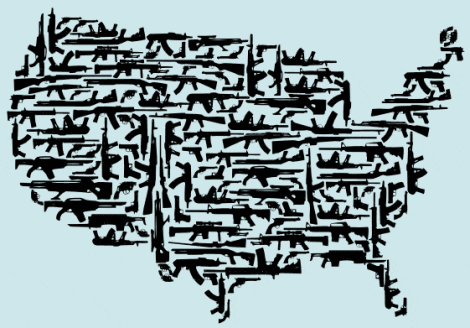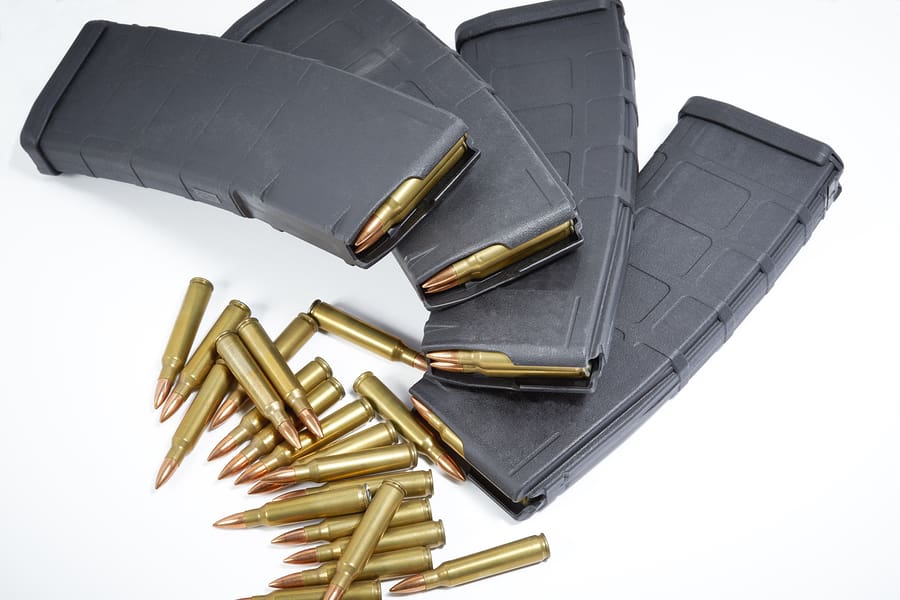Gun control advocates can’t sway the public toward their point-of-view by proving the effectiveness of their “solution.” Because it isn’t. A solution, that is. Instead, they continuously wail about how terrible the “gun violence” problem is, demanding that something must be done. That something: gun control!
To that end the Urban Institute has released a study called A Neighborhood-Level Analysis of the Economic Impact of Gun Violence. Funded entirely by Everytown for Gun Safety (which is in turn entirely funded by former New York City Mayor Michael Bloomberg), the study seeks to illustrate how “the scourge of gun violence” impacts more than just the perpetrators and victims. The Urban Institute claims it drives down home values, businesses and even individual credit scores.
The problem: the study documents the cost of “gun violence” in only six carefully selected cities: Baton Rouge, LA, Minneapolis, MN, Oakland, CA, Rochester, NY, San Francisco, CA and Washington, DC. Notably absent from the list: more notorious locales such as Chicago, Baltimore, St.Louis, Memphis and Detroit…cities which immediately spring to mind when the phrase “gun violence” is uttered.
Another problem: the results were generated by interviewing — again — carefully selected “homeowners, renters, business owners, and representatives of neighborhood associations and other nonprofit organizations.” Notably absent among the interviewees: anyone else.
The survey said! . . .
Analysis of gun homicides in 2014 and home values, home ownership rates, and credit scores in 2015 demonstrated that each additional gun homicide in a census tract was associated with the following outcomes:
A $22,000 decrease in average home values in Minneapolis census tracts and a $24,621 decrease in Oakland census tracts.
A 20-point decrease in average credit scores in Minneapolis census tracts and a 9-point decrease in Oakland census tracts.
A 3 percent decrease in homeownership rates in Washington, DC, census tracts and a 1 percent decrease in Baton Rouge census tracts.
People don’t want to live or work in an area where there’s been an incident of gun violence. That’s a conclusion about as obvious and useful as Donald Trump’s views on exercise.
At face value, the conclusion sounds problematic. If gun violence drives down home prices and credit scores in an area, it makes those living there less capable of moving out, trapping them and leading to a perpetuation of violence. But I have a couple questions.
Which came first: the poverty or the gun violence?
Correlation never specifically equals causation. Proving that the decrease in credit scores and home values is a direct result of the gun violence is nearly impossible. In fact, the same data could well indicate that poverty is a predictor of gun violence and that lower credit scores attract gun violence to an area.
Is it specifically “gun violence” or just violence in general that’s allegedly at fault?
The study focuses on “gun violence” because there’s clearly an agenda at work here — demonizing individual firearms ownership and trying to show that guns create poverty. In reality, crimes involving a firearm are a fraction of the total violent crime in any locale. According to the Bureau of Justice Statistics only 22 percent of all violent crimes were committed by an offender wielding a weapon (gun, knife or other object). The remainder of violent crimes — 78 percent — did not involve a firearm.
Removing the impact of the other forms of violent crime — and isolating the effects of “gun violence” — on an area is impossible. How much of the reduction in credit scores was specifically due to gun violence and how much was due to the other 78 percent of crimes committed in the area? The study doesn’t say because the methodology assumes that gun violence is the cause of any negative outcomes in the surveyed areas, ignoring other factors.
Blaming the outcome (economic poverty) on a single relatively small variables (“gun violence”) is the same as blaming Hillary Clinton’s loss solely on misogynistic white males. Sure some of them voted for Trump. But focusing on the “redneck issue” is a bad landing at the wrong airport; it ignores larger issues and keeps Democrats from taking effective corrective action. [ED: thankfully]
To find a solution to “gun violence” you have to understand the whole picture, including factors such as housing, education, cultural considerations, socio-economic data, policing practices and the criminal justice system. But that’s something Michael Bloomberg and his paid shills won’t do. Something they can’t do. Because no matter how many studies they gin up, the facts simply don’t support their anti-gun rights agenda.





Poverty does not cause crime.
Crime causes poverty.
So the reason I’m broke and my credit sucks is because I keep buying guns? 🙂
. . . wearing your pajamas all the time & you forgot to shave. . .
no, wait, that was Al Qaeda.
Look into the statistics and the facts. Also look up the Gini index.
Poverty does not cause crime. Pervasive criminality in a community leads to poverty.
http://www.nationalreview.com/article/392865/poverty-doesnt-cause-crime-dennis-prager
http://thehill.com/blogs/pundits-blog/crime/322568-violence-is-a-symptom-of-poverty-not-a-cause
https://www.psychologytoday.com/blog/inside-the-criminal-mind/201412/crime-causes-poverty
https://www.opendemocracy.net/transformation/andy-west/does-poverty-cause-crime
What if both crime and poverty are caused by third factor? Like say considering work icky, unwillingness to follow rules or simply low IQ.
Guns don’t make home values drop, or make businesses run away. Criminal acts do. In fact, you could argue the opposite. If everyone carried around guns for protection, eventually those violent people, less intelligent people prone to violence would be eliminated from the population, and only the non-impulsive intelligent industrious non violent people would remain.
Even if you could magically make all the guns disappear, the criminal acts would remain. There would be robberies, knife attacks, burglaries, rapes, assaults. Home values and businesses aren’t going to return if guns magically disappeared. The obsessive gun haters should look to reason and facts before peddling nonsense.
“The obsessive gun haters should look to reason and facts before peddling nonsense”.
Good luck with that….
So Britain must be poverty free right? Guns cause businesses to run for the hills so Britain must be raking in new businesses and industry by the boatload. That’s why china has stolen so many of our manufacturing jobs right?
I will admit though the less I go to the range the more money I have in my wallet. Guns do create poverty!
That’s a common refrain, that China, Mexico, or whoever else has “stolen” our manufacturing jobs and that our manufacturing industry has vanished. Even Trump campaigned on that myth.
Those countries certainly have increased their own manufacturing bases and they do export goods to the U.S. However, that’s not to say that they’ve stolen anything, let alone that our manufacturing sector has vanished.
What leads people to think that is that, well, that there has been a decline in employment in U.S. manufacturing: a decline from 17.3 million in 2000 to 12.3 million in 2015, a decline from 1/3 of U.S. employment at its WWII height to just 8.7% of employment in 2015. People equate employment declines with jobs having been “stolen” and with the overall size and vitality of that sector of the economy. Alas, neither is true, but that doesn’t shake people’s perceptions.
The proof? In Colonial America, agriculture (largely subsistence) was the occupation of some 90% of the population. Today it’s about 1% of the population, which tiny group feeds Americans to gluttonous excess, exports food worldwide, and is even paid not to farm in some cases. Farming and food haven’t vanished, despite the reduction in percentage of the workforce engaged in agriculture. Neither has manufacturing.
It’s just that manufacturing has gotten much more efficient, just like agriculture, through technology and improved operating processes. In fact, measured in trillions of dollars of annual output, Manufacturing is the largest sector of the U.S. economy, roughly four times that of Information. Measured in terms of actual, physical output, U.S. factories are operating at near record levels. Output in 2015, for example, was twice as high as in the 1980s, but uses about one-third fewer workers. The sector also tends to produce higher margin, higher tech items, too, rather than cheap toys like China.
Anyway, there’s volumes more to this story than space here allows. Suffice it to say that while chatting up a bitter, retired labor unionist or strolling the aisles of the local Walmart can be somewhat informative, they are hardly dispositive of the question of U.S. manufacturing.
“Gun violence” reduces property values in San Francisco? I wish. The cost of a house in the city exceeds $1 million. An extended family member lives there in a nicer area near Noe Valley (except for the homeless), and the asking price of the three bedroom house they live in is over $3 million. I wish MY property values could get so “depressed.”
So you mean a lack of real controls affects the outcome of a study? You don’t say.
I have been in every single neighborhood in Chicago. I can assure you it’s evil people dropping home prices and lowering credit scores. Guns are inanimate objects. Why isn’t rural non-immigrant Minnesota or Wyoming the most violent spot in America? Tons o’ guns but very low crime…duh.
The other day Mark Steyn commenting on ‘climate change’ said. “It’s cartoon science. That’s why they like it, because it’s simple and it appeals to them,” he added later. “These people are invested in a cartoon idea of science that actually thinks that if you get all of the clever people around the table, they can set the global thermostat for the year 2100 and the planet is going to comply with that.”
I think there’s a valid paraphrase there for this Bloomberg-financed “Study” about “gun violence”, except Bloomie’s “clever people” are agenda driven ideologues where a whole table of them does not amount to one slightly clever person…barely makes one demonstrably stupid person in fact.
It is violence. Just violence. We need to start calling it what it is. Violence done by violence people.
Gotta be guns…..
Couldn’t be that lovely crack-house on the corner….
or the turds in the street….
or the aggressive panhandlers and prostitutes…..
or just a dingy-ass city that didn’t keep up…
Yeah….gotta be guns
The study’s logic could be illustrated as such:
“We found out that every wet place also had water at some point, therefore wetness causes water.”
They misunderstand causation and correlation
I got it! The liberal talking point of the day!
Black guns cause global warming! They absorb all that UV, and that melts the polar caps so the unicorns can’t graze on fields of cotton candy!
Oh, wait. Black guns. That’s racist.
WEAPONS OF COLOR!! There. I got that figured out. Damn, it’s hard thinking like a liberal.
Don’t forget to find something to be deeply offended by that needs you to raise awareness like unicorn extinction. Where will Starbucks get the unicorns for their frappacino?
Yeah it MUST be the guns not the crackheads, chickenheads, wetbacks, ghetto thugs, dopers, deadbeats, welfare queens, super predators (thank Hillary Clinton for THAT one), corrupt Democratic Party dominated local governments and their waste, fraud, and generally illiterate masses.
Well, whoever they talked to in Rochester, NY, it wasn’t me.
There’s no need for “violence” of any kind to explain poverty in Rochester. Yes, there’s a significant “concentrated poverty” issue in Rochester. The region also has a problem with being in NY State, a generation’s population outflow, and a generation and a half collapse of the iconic companies that were the foundation of the economy for a generation and a half before that.
You don’t want a giant fish & pilot fish economy. You want more diversity, in particular trading out of the region. Having a bunch of pilot fish feeding off of the only three (or four, if you count Delco) giant companies that sell outside the county. So, why the concentrated poverty? Second-order pilot fish: service jobs supporting the people in the iconic companies, and in the companies selling them services.
“Baton Rouge, LA, Minneapolis, MN, Oakland, CA, Rochester, NY, San Francisco, CA and Washington, DC.”
Please note how many of those are in the middle of blue state utopias.
Reminds me of the intentionally dishonest strategy used when people quote 3rd wold death statistics for things like measles when they’re pushing the vaccine agenda.